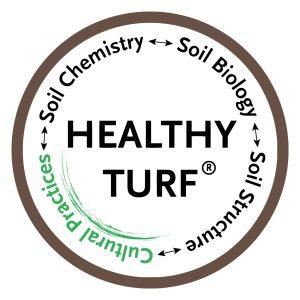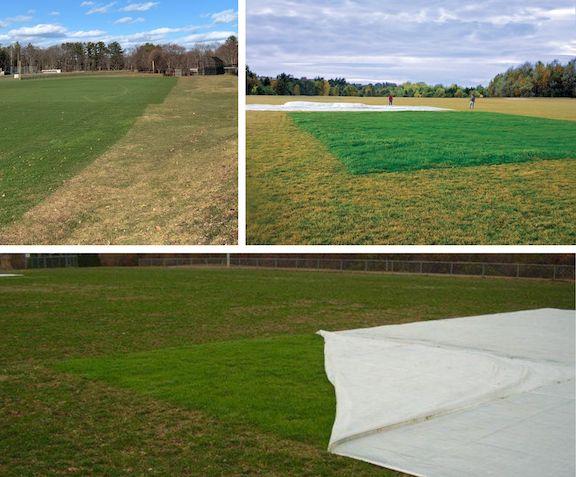The fourth element of our Healthy Turf Circle is cultural practices and turf care. Even the best soil care program can fall short without the proper attention to these essential practices. It takes time to make significant changes to soil conditions. Therefore, it’s important to get the cultural practices right to build year-over-year success. Dialing in mowing, watering, aeration and over-seeding is the key to your success. View our blog page for pasts posts on Soil Chemistry, Soil Biology, and Soil Structure.

1. Key Mowing Guidelines
Proper mowing is by far the most important cultural practice. It promotes consistent turf density and resilience; Reduces weed competition by maintaining a healthy turf canopy; Contributes to soil organic matter, enhancing long-term turf health.
-
Maintain Proper Mowing Height: Mow as high as possible for use. The higher the cut, the more leaf surface is available for photosynthesis which is necessary for plants to thrive. Choose a height that aligns with your ability to manage the labor demand from mowing frequency. Example: cutting at 3½″ typically requires mowing once per week which is manageable for most residential properties . An athletic field cut at 2″ may need mowing up to three times per week. Only 1/3 of the turf plant should be removed at any time to minimize stress. If grass has gotten long you may need to double cut to disperse clippings – long clippings left on the grass will smother and kill the existing turf leaving bare spots. Avoid cutting when wet to help minimize tearing and clumping as well
-
Use Sharp Blades: Torn grass blades are more susceptible to disease and can negatively impact the visual appeal of turf. Replace or sharpen blades after every 24 hours of use to prevent tearing the turf.
-
Return Grass Clippings: Avoid bagging clippings unless weeds flowers/seeds are present or absolutely necessary because grass is too long. Returning clippings adds valuable organic matter to the soil.
2. Watering Your Lawns and Athletic Fields
PJC has adopted the 1-2-3-2-1 Watering Method. Since drought and watering restrictions have become the new normal in the Northeast, you want to have a plan for irrigating. So, ensure infrequent, deep watering to get the best level of performance from your fields and lawns. Ideally, watering should not exceed 1.25″/week and we consider 1″ of water to be optimal.

Be sure to audit your irrigation systems throughout the season to maximize coverage and efficiency. Our 1-2-3-2-1 table (pictured above) provides rough estimates for watering times for different style heads. It’s wise to test your systems using the “Tuna Can Test”. Run your system and start a timer to see how long it takes to fill the 1″ can. Then, divide the time by the frequency of watering per week.
More is not always better in the case of watering. Frequent shallow watering results in shallow roots and higher competition from undesired turf species, fungus, and weeds. We want deep root watering to create an enduring turf stand. In spring and fall, dial those systems back to 1x/ week and let nature run its course with rainfall. In summer drought, 3x/week is necessary (when allowed). Deep watering encourages turf plant roots to “search” for water and forces roots to grow deeper into the soil profile.
3. Aeration: Relieving Compaction and Boosting Turf Health
Aeration is a mechanical process essential for reducing soil compaction and delivering nutrients directly into the rhizosphere (root zone). This practice improves air and water movement within the soil profile, creating an ideal environment for turfgrass roots to thrive.
Notably, compacted soil restricts root growth and limits the movement of water, nutrients, and air. Remember, turf roots grow in the soil’s pore spaces. Maintaining these spaces fosters stronger root systems and better turf health. Mechanical aeration is the most effective way to address these issues, especially on high-use surfaces like sports fields.
Home lawns typically endure less stress than athletic fields. Therefore, lawns can get by with 1 fall aeration per season. Conversely, high-traffic athletic fields typically require multiple aerations throughout the growing season to keep up with the demands of heavy use. Timely aeration ensures turf performance and resilience.
Long-Term Benefits of Aeration:
- Improved nutrient uptake.
- Better water retention and drainage.
- Enhanced overall turf health and durability, paying dividends year after year.
4. Over-seeding
Turf plants get tired as they age and in most managed landscapes grass is not allowed to grow long enough to reseed itself. Introducing new turf plants and species brings vitality and vigor into your turf stand. Additionally, seed engineers are always working to develop new turf species that are more drought tolerant and require less fertilizer. Different turf varieties have different germination, establishment periods, and conditions they tolerate. Germination can range anywhere from 1-6 weeks and establishment 9 -12 months, respectively. Therefore, utilizing the right seed blends at the right time of the year is critical to your success. If you can only seed once, the ideal time is the fall. Fall over seeding allows you to avoid the stress of keeping young turf alive through the summer heat and water restrictions. As well as giving the young turf a longer window to establish before it first sees summer heat the following spring.
It’s important to get seed-to-soil contact and establish new turf plants to crowd out weeds. For mechanical over seeding, we recommend utilizing a slice or slit seeder for spring seeding. As it provides good seed to soil contact while minimizing disruption to the existing weed bank and risk of introducing weed seeds to the surface. In the fall, where weed germination is a lower concern, aeration is a great way to improve seed to soil contact. While also helping to reduce compaction in turf. We recommend using core or plug aeration for better soil contact vs solid tine. Overseeding may seem cost prohibitive, it’s important though to establishment of a healthy stand of turf that will out compete weeds.
5. Weed Management
When you are looking at weeds present in your lawn, ask yourself: “Why is this weed here?” The answer may come back to the underlying soil conditions (particularly as it relates to soil pH) AND/OR could be from improper cultural practices.
Often calcium—a macronutrient—becomes unavailable. Consequently, we see plants such as plantain and dandelion thrive due to their ability to “break” soil with large tap roots and make calcium available to themselves these weeds also indicate compaction in the soil. So in addition to raising the Ca in the soil aeration should also be used to lessen compaction and allow desirable turf grass to grow easier in those areas.
Dreaded crabgrass does an outstanding job competing with its prostrate growth habit and ability to reproduce rapidly. A combination of poor soil, drought conditions and low mowing allow for crabgrass to proliferate. Raising your height of cut to shade the soil and not watering frequently when it is about to germinate will help. We often see non-irrigated turf with significantly less crab grass than irrigated and it will still bounce back well at the end of the summer
“Grassy weeds”—such as poa annua—thrive in wet soil conditions and typically burn out in the summer Over watering makes the situation worse.
6. Turf Blankets
Turf blankets have proven to be effective in early spring green up and giving a competitive edge to turf grass coming out of winter. While temperatures don’t always cooperate in the spring, turf blankets allow for air movement between the field and atmosphere and capture heat to make your field think it’s much warmer outside. They will help especially with faster germination in the spring for early season seeding.
With the winter we’ve had it’s not too late to get some turf blankets down and dormant seed to repair goal mouths and trouble spots before the season gets started.

PJC’s Practical Approach
Notice a trend? By mowing high, watering appropriately, and addressing soil fertility and pH you are going to grow healthier turf grass and lessen weed prevalence. Just because you remove a weed doesn’t mean grass will magically come back in those spaces. Overseeding these bare areas is important to reestablish turf.
Our Healthy Turf Circle was carefully crafted by examining years of research. In conclusion, the combo of Soil Chemistry, Soil Biology, Soil Structure and Cultural Practices creates a holistic approach to organic turf care management. The success of your organic turf care program lies in your ability to maximize components of the Healthy Turf Circle and address each aspect each year. Lastly, implementing proper cultural practices lay the groundwork for year-over-year success.
Got questions on cultural practices and turf care? Want to purchase product? Need help developing an Organic Turf Care Program? Just want more info on PJC and how we’ve made organic work?? Contact us!
